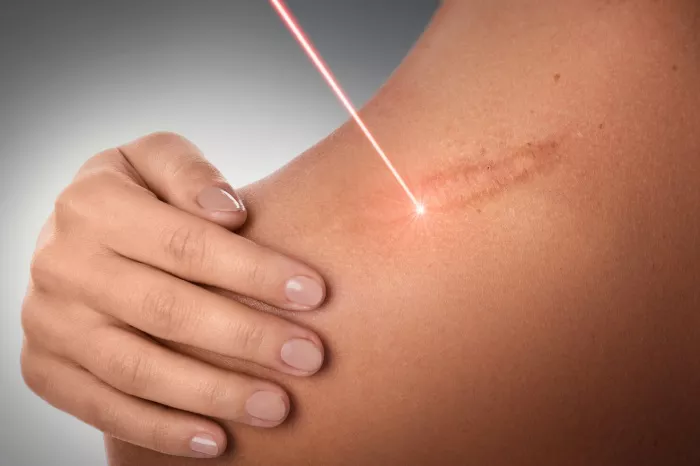Laser scar removal stands at the forefront of modern dermatological advancements, offering a transformative solution to minimize the visible traces of scars. As individuals seek the most effective methods to correct scars, a common inquiry persists: How many procedures are needed for laser scar removal? This comprehensive exploration navigates the landscape of laser scar resurfacing, unraveling the factors that influence the number of sessions required, the frequency of treatments, and the overarching quest for optimal results. From understanding the intricacies of scar correction to exploring the nuances of laser technology, this guide aims to provide clarity on the journey toward scar-free skin.
Laser Scar Removal: How Many Procedures Do You Need to Do to Correct a Scar?
The number of laser procedures required for scar correction varies based on several factors, including the type of scar, its size, depth, and the specific laser technology employed. While some scars may respond effectively to a single session, others may necessitate multiple treatments for noticeable improvement. For individuals with hypertrophic or keloid scars, characterized by raised and thickened tissue, a series of laser sessions may be recommended to gradually reduce the prominence of the scar.
Understanding the Types of Scars: Tailoring Laser Treatment Approaches
Scars manifest in diverse forms, each presenting unique challenges and characteristics. Hypertrophic scars, keloids, atrophic scars, and acne scars are among the variations that individuals may seek to address through laser scar removal. Tailoring laser treatment approaches to the specific type of scar is essential for achieving optimal outcomes. For instance, ablative lasers may be more effective for atrophic scars, while non-ablative lasers are often employed for hypertrophic or keloid scars. The nature of the scar influences the number of sessions required, with some responding more favorably to laser treatment than others.
How Many Laser Treatments Do You Need to Do to Remove a Scar?
The number of laser treatments needed to remove a scar is contingent on factors such as the scar’s characteristics, the chosen laser modality, and the individual’s response to treatment. In many cases, a series of laser sessions spaced over weeks or months is recommended to gradually diminish the appearance of scars. The goal is not only to reduce the visible aspects of the scar but also to stimulate collagen production and remodeling, fostering long-term improvements in skin texture and tone. The choice between fractional laser treatments, ablative lasers, or non-ablative lasers further influences the treatment timeline.
How Often Can Laser Scar Resurfacing Be Done?
The frequency of laser scar resurfacing sessions is a critical consideration in the scar correction journey. While the exact interval between sessions varies based on individual factors and the type of laser used, a common approach is to space treatments several weeks apart. This interval allows the skin to heal and recover between sessions, minimizing the risk of adverse effects and optimizing the cumulative benefits of laser scar removal. Dermatologists and laser specialists assess the skin’s response to each session, adjusting the treatment plan as needed to achieve the desired outcomes.
Factors Influencing Treatment Frequency
Several factors influence the frequency of laser scar resurfacing treatments, including:
Type of Laser Used: Different lasers operate on varied wavelengths and penetration depths. The choice of laser technology influences how often treatments can be administered and the duration required between sessions.
Skin Type and Sensitivity: Individual skin characteristics, such as sensitivity and the likelihood of adverse reactions, impact the recommended frequency of laser treatments. Skin type assessments guide the customization of scar correction plans.
Severity and Type of Scar: The severity and type of scar are integral considerations. Deep scars or scars with complex characteristics may necessitate a more conservative approach, spacing treatments to allow for optimal healing.
Patient’s Healing Capacity: The body’s capacity for healing and responding to laser treatments varies among individuals. Factors such as overall health, immune function, and lifestyle habits contribute to the healing process and influence treatment frequency.
Realistic Expectations
It’s crucial for individuals undergoing laser scar removal to set realistic expectations regarding the gradual progress of the procedure. Achieving significant improvements in the appearance of scars often requires patience, as the skin undergoes a process of renewal and regeneration. While some individuals may observe visible changes after a few sessions, others may require additional treatments for optimal results. Understanding the transformative journey of laser scar removal involves acknowledging that the process unfolds over time, with each session contributing to the overall refinement of the skin’s texture and tone.
Combination Approaches
In certain cases, dermatologists may recommend combination approaches to enhance the efficacy of laser scar removal. Adjunctive therapies, such as topical treatments, microneedling, or injectable fillers, may complement laser sessions for a comprehensive and synergistic effect. These combination approaches are tailored to the specific characteristics of the scar and the individual’s unique skin needs. Integrating multiple modalities allows for a holistic and targeted approach to scar correction, addressing both surface irregularities and the underlying structural components.
Post-Treatment Care
Post-treatment care is integral to the success of laser scar removal. Following each session, individuals are typically advised to adhere to specific care guidelines to nurture the healing process and optimize results. Sun protection, gentle cleansing, and the application of recommended skincare products contribute to a supportive post-treatment environment. Dermatologists may also provide guidance on avoiding potential irritants or activities that could compromise the healing skin.
Conclusion
In conclusion, the journey of laser scar removal is a dynamic and personalized endeavor, influenced by the unique characteristics of each scar and the individual’s response to treatment. The question of how many procedures are needed for laser scar removal underscores the multifaceted nature of scar correction. The path to scar-free skin involves a strategic and patient approach, with dermatologists and laser specialists customizing treatment plans based on scar type, severity, and individual factors.
Understanding the intricacies of collagen remodeling, treatment frequency, and the gradual progress of laser scar removal contributes to informed decision-making and realistic expectations. The transformative potential of laser scar removal lies not only in the visible reduction of scars but also in the stimulation of collagen production, fostering enduring improvements in skin texture and tone.
As individuals embark on the quest for skin confidence through laser scar removal, the collaboration with experienced dermatologists and the integration of post-treatment care practices become essential elements in sculpting a path toward optimal results. By embracing the advancements in laser technology and the artistry of scar correction, individuals can confidently stride toward a future where scars are no longer the defining feature, but rather a testament to the resilience and transformative power of modern dermatological science.
[inline_related_posts title=”You Might Be Interested In” title_align=”left” style=”list” number=”6″ align=”none” ids=”3359,3331,3363″ by=”categories” orderby=”rand” order=”DESC” hide_thumb=”no” thumb_right=”no” views=”no” date=”yes” grid_columns=”2″ post_type=”” tax=””]































